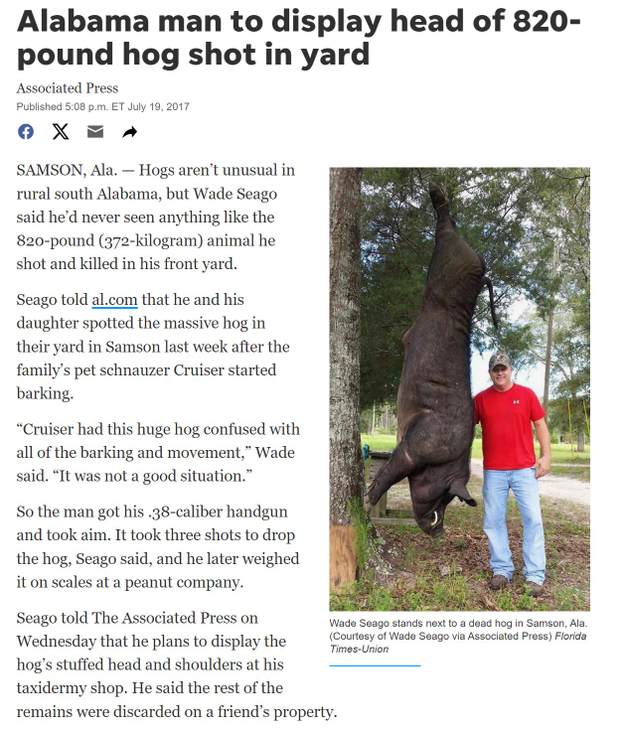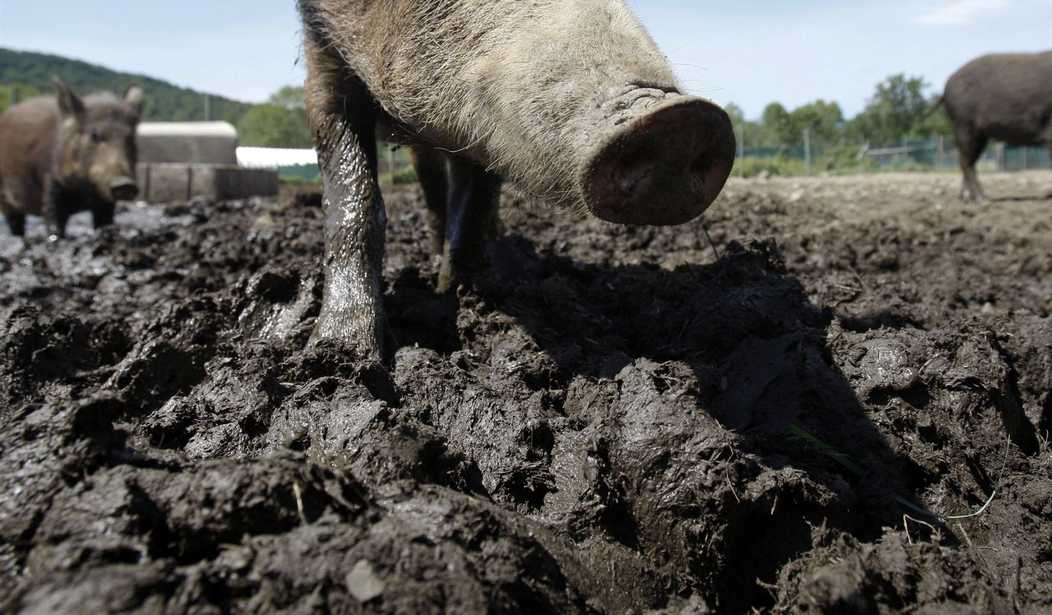Among the odds and ends of the newsletters I get, there’s a pretty neat little agricultural one that shows up a couple times a week. I subscribed mostly for the information on poultry, both for background for posts here and big dreams of maybe someday having a couple chickens in the backyard. Yeah, someday.
What’s neat about it, though, is how wide-ranging it is – from crop-yields to fertilizers, beef production to pesticides and building barns or siloes. Way cool stuff about how our food is made.
Yesterday’s missive though, now that had a doozy pair of adventure stories in it that hit close to home, as we have a massive problem here, too, with the villains of the piece – feral hogs.
They are ugly, mean, non-native (invasive) to the US, they multiply like Tribbles, and a good portion of the country has no idea what they cost as far as agricultural damage done every year. Nor do most people realize how big and dangerous they can be. The two stories in the ag article – from Mississippi and Florida – are pretty scary, and the pictures of the one guy’s encounter are gruesome, so I’ll leave it to you all to check that out.
15 years ago, when my Daddy lived just outside the city limits of Cleburne, Texas, he would tell me that he and the neighbors would hear the hogs behind them late at night. Of course, the vision of my tall but frail father with his bad hip, letting their dog out late at night, and getting stomped by a boar was never far my mind after that. Fathers can be intractable, hard-headed dopes.
I was very relieved when they bought a house darn near in town, especially after we ran into their former next door neighbor when we were out to dinner one night. He’d had enough of the pigs, especially with a couple small children, and neighbors formed a pig posse. The picture he showed us of the 300 pounder he’d shot almost directly behind where my Daddy had lived – SMOKES.
It fed the neighborhood.
Texas has a real pig problem on their hands.
Even in our carefully ordered world, there remain avenues for chaos to thrive in its purest form: the wild pig. Groups of them, called sounders, cavort across golf courses at night like drunken teenagers. Security cameras catch them careering through suburban neighborhoods, where they dig up gardens and lawns. They create shambolic crop circles in fields—Texas’s agriculture industry alone suffers $118.8 million in damages annually. The most recent estimates suggest that tens of thousands of them are involved in car accidents each year. They affront us even in death, vandalizing graves as they barrel through cemeteries.
Like giant, pungent bedbugs, wild pigs provide little value to the ecosystem. Though they have been in North America since the sixteenth century, the population began compounding itself in recent decades and reached a tipping point, rendering the limited control efforts—including trapping, fencing, and hunting—cartoonishly insufficient. A 2003 publication by the Texas Parks and Wildlife Department estimated that there were 1.5 million wild pigs in Texas. In 2012 a group of scientists estimated that the population had swelled to between 1.8 and 3.4 million. John Tomeček, an associate professor at Texas A&M University and a wildlife specialist with Texas A&M AgriLife Extension Service, recently put the number at 3 or 4 million. “Probably more,” Tomeček said, “but that’s a conservative number.” (For perspective, the combined human population of Houston and Dallas is about 3.6 million.)
But it’s not just TX – feral pigs have taken over from California to Florida. They can live anywhere, on anything, are smart as whips, and easily figure out how to survive and thrive.
They are causing so much destruction in CA, that gun hating Gavin Newsom recently signed a bill that eliminated the previous hunting requirement for a $25 permit per pig. It’s now a one-time $15 unlimited permit. The numbers are staggering, and when you think of a porcine predator that is omnivorous, can be dangerously aggressive, and weigh hundreds of pounds? Well, that’s what we’d worry about. I’m sure Newsom’s thought processes were more on the lawn and landscaping roto-tilling they do.
A bill addressing how to handle up to 400,000 wild pigs that are roaming across California has been signed into law by Gov. Gavin Newsom.
Senate Bill 856, authored by state Sen. Bill Dodd, D-Napa, will loosen regulations and lower hunting fees for killing the wild pigs, which have been found in 56 of the state’s 58 counties, excepting only San Francisco and Alpine counties.
The bill passed without any votes in opposition in both the state Senate and Assembly and was sent in late August to the governor. SB 856 allows someone to kill an unlimited number of wild pigs as well as prohibiting someone from intentionally releasing a pig to live in the wild, among other changes in state law.
…The growing number of the pigs isn’t just a California problem — they were found in 544 counties nationwide 40 years ago, but are in 1,915 counties as of 2020, said Ari Cornman, wildlife advisor for the Fish and Game Commission.
The feral pig population – particularly in CA – has also caused millions of dollars worth of agricultural damage indirectly. Not by digging up fields, which they do routinely, but what they leave in them while there. Salmonella recalls of food products are expensive, and can be pig-poopie related. Dole found that out with a spinach recall.
…The outbreak, which occurred in early fall, sickened 205 people and caused three deaths.
…There, officials found the outbreak strain in river water, cattle feces, and wild-pig feces. A grass-fed cattle operation was located on the ranch, less than a mile from the spinach field, the report says. Investigators found evidence of wild pigs in and around the cattle, growing, and irrigation well areas.
The national estimates for crop damage is a lot for farmers to absorb. They are a flat out ecological menace.
…The animal version of runaway rototillers, invasive wild pigs (also known as razorbacks or feral swine) have already destroyed soccer fields and residential yards in the Bay Area. And that’s just an annoyance compared to the harm they cause to agriculture, ecosystems and possibly even human health. Wild pigs don’t just dig up flower gardens; they also tear up fields of corn, cotton and rice. Estimates of the damage they cause in the U.S. range from $1.5 billion to $2.5 billion every year.
Locally, estimates in next-door Alabama are that they do at least $50M worth of crop damage every year and are the reason behind the booming alligator population in the Mobile Bay estuary. No large primordial reptile goes hungry over there. They just have to skulk along the edge of one of the feeder rivers like a crocodile at the Maasai Mara crossing. The dinner bell WILL ring.
Pigs are are raising hell everywhere in the state.
In Florida, ferals have even devastated sea turtle populations, because they’ll root through the sand and snarf up the eggs during nesting season – they are that adaptable.
What to do? Some states are trying poisons. Keep hunting. Make the hunting easier in states where it’s still restricted. This is a non-native, destructive, invasive species menace, not a native population that needs to be kept under control to insure its own survival.
And they can get really BIG.

Could you feed the country with them? With all the diseases they naturally carry, they have to be handled pretty carefully through processing, but there are organizations who are already up to speed on how to do it. You just have to make doubly sure you cook the swine thoroughly.
Nothing that a solid 6-12 hour pig roast with some Lexington style sauce afterward couldn’t handle.
It’s one solution.








Join the conversation as a VIP Member